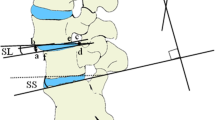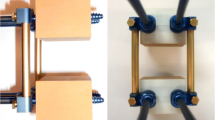Abstract
Several biomechanical studies have evaluated the quality of fusion obtained with a rigid versus a semi-rigid pedicle screw implant. Some studies indicate that increased rigidity of the implant system results in an increased strength of the fusion mass. Other reports have underlined the risk of stress shielding due to rigid implant systems. Based on these findings some authors have recommended the use of a semi-rigid system. There are, however, few studies focusing on any possible difference in clinical outcome between the two different types of implant systems. Questionnaires were sent to 89 patients who had undergone primary spinal fusion with either a rigid or a semi-rigid pedicle-screw-based implant system. In every case the diagnosis was spondylolisthesis or degenerative lumbar disease. The questionnnaires were analysed using forward stepwise logistic regression analysis. Eighty (90%) of the questionnaires were returned. There was a mean follow-up of 4 years (range 2–8 years). It was not possible to demonstrate any difference in clinical outcome between patients undergoing lumbar fusion with a rigid implant system and those given a semi-rigid system. The overall patient satisfaction rate was 69%, with no difference between the two types of implant. No difference in clinical outcome between the two types of implant was found. Considering the fact that the primary goal of spinal fusion procedure is to obtain a solid fusion mass, biomechanical tests favour the used of a rigid pedicle screw system. This fact combined with the fact that early mobilisation is possible with rigid implants justifies the use of rigid implant systems, although no difference in clinical outcome could be demonstrated in this study.
Similar content being viewed by others
References
Ashman RB, Galpin RD, Corin JD, et al. (1989) Biomechanical analysis of pedicle screw instrumentation systems in a corporectomy model. Spine 14: 1398–1405
Bloch R (1987) Methodology of clinical back pain trials. Spine 12:430–432
Blumenthal SL, Gill K (1993) Can lumbar spine radiographs accurately determine fusion in postoperative patients? Correlation of routine radiographs with a second surgical look at lumbar fusions. Spine 18:1186–1189
Brodsky AE, Kovalsky ES, Khalil MA (1991) Correlation of radiologic assessment of lumbar spine fusions with surgical exploration. Spine [Suppl] 16: 261–265
Cotrel Y, Dubousset J, Guillauman M (1988) New universal instrumentation in spinal surgery. Clin Orthop 227: 1023
Greenough CG, Fraser RD (1989) The effects of compensation on recovery from low-back injury. Spine 14:947–955
Gurr KG, McAfee PC, Warden KE, et al. (1989) Roentgenographic and biomechanical analysis of lumbar fusions: a canine model. J Orthop Res 7:1216–1222
Horowitch A, Peek RD, Thomas JC, et al. (1989) The Wiltse pedicle screw fixation system: early clinical results. Spine 14:461–467
Johnsson R, Strömqvist B, Axelsson P, et al. (1992) Influence of spinal immobilization on consolidation of posterolateral lumbosacral fusion. A roentgen stereophotogrammetric and radio graphic analysis. Spine 17: 16–21
Johnston CE, Ashman RB, Baird AM, et al. (1990) Effect of spinal construct stiffness on early fusion mass incorporation. Spine 15:908–912
Johnston CE, Welch RD, Baker KJ, et al. (1995) Effect of spinal construct stiffness on short segment fusion mass incorporation. Spine 20:2400–2407
Kant AP, Daum WJ, Dean M, et al. (1995) Evaluation of lumbar spine fusion. Plain radiographs versus direct surgical exploration and observation. Spine 20:2313–2317
Keller RB, Rudicel SA, Liang MH (1993) Outcomes research in orthopaedics. J Bone Joint Surg [Am] 75: 1562–1574
Kiviluoto O, Santavira A, Salenius P, et al. (1985) Posterolateral spine fusion. A 1–4 year follow-up of 80 consecutive patients. Acta Orthop Scand 56:152–154
Lipscomb HJ, Grubb SA, Talmage RV (1989) Spinal bone density following spinal fusion. Spine 14:477–479
McAfee PC, Farey ID, Sutterlin CE, et al. (1989) Device-related osteoporosis with spinal instrumentation. Spine 14: 9–14
Meyerding HW (1932) Spondylolisthesis. Surg Gynecol Obstet 54:371–377
Nachemson AL (1993) Evaluation of results in lumbar spine surgery. Acta Orthop Scand 64: 130–133
O'Beirne J, O'Neill D, Gallagher J, et al. (1992) Spinal fusion for back pain: a clinical and radiographical review. J Spinal Disord 5:32–38
Pearcy M, Burrough S (1982) Assessment of bony union after interbody fusion of the lumbar spine using a biplanar radiographic technique. J Bone Joint Surg [Br] 64:228–232
Pihlajamäki H, Böstman O, Ruuskanen M, et al. (1996) Posterolateral lumbosacral fusion with transpedicular fixation. 63 consecutive cases followed for 4 (2–6) years. Acta Orthop Scand 67:63–68
Roy-Camille R, Benazet J, Desauge JP, et al. (1993) Lumbosacral fusion with pedicular screw plating instrumentation. A 10-year follow-up. Acta Orthop Scand 64:100–104
Roy-Camille R, Saillant G, Berteaux D, et al. (1976) Osteosynthesis of thoraco-lumbar spine fractures with metal plates screwed through the vertebral pedicles. Reconstr Surg Traumatol 15:2–16
Roy-Camille R, Saillant G, Mazel C (1986) Internal fixation of the lumbar spine with pedicle screw plating. Clin Orthop 203:7–17
Stefee AD, Biscup RS, Sitkowski DJ (1986) Segmental spine plates with pedicle screw fixation. A new internal fixation device for disorders of the lumbar thoracolumbar spine. Clin Orthop 203:45–53
Stefee AD, Sitkowski DJ (1988) Reduction and stabilization of grade IV spondylolisthesis. Clin Orthop 227:82–89
Turner JA, Ersek M, Herron L, et al. (1992) Patient outcomes after lumbar spinal fusions. JAMA 268:907–977
Zdeblick TA (1993) A prospective, randomized study of lumbar fusion. Spine 18:983–991
Author information
Authors and Affiliations
Rights and permissions
About this article
Cite this article
Dahl, B., Gehrchen, P., Blyme, P. et al. Clinical outcome after spinal fusion with a rigid versus a semi-rigid pedicle screw system. Eur Spine J 6, 412–416 (1997). https://doi.org/10.1007/BF01834071
Received:
Revised:
Accepted:
Issue Date:
DOI: https://doi.org/10.1007/BF01834071




